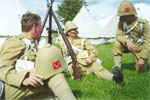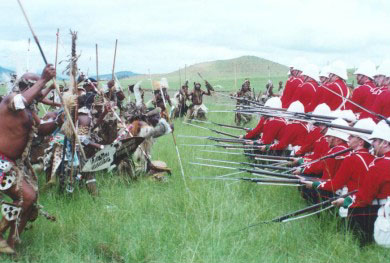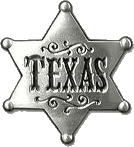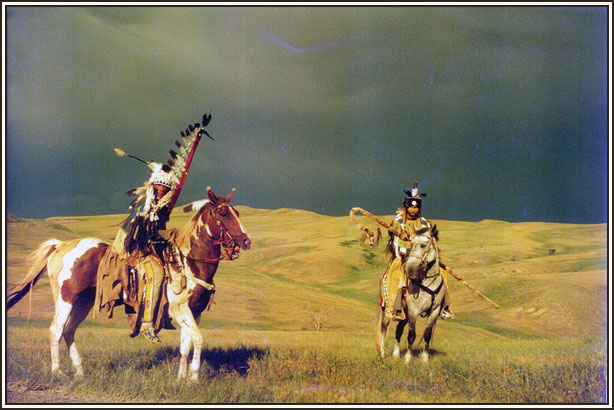- reenactor.Net, THE Online, Worldwide Home of Living History »
- 1870-1900
 Indian Wars Reenacting Units
Indian Wars Reenacting Units
Soldierly Life
The Buffalo Soldiers
Marriage and the Soldier
To add your unit link, please go
|

1st US Cavalry, Company K This reenactment group reenacts Dragoon, Civil War, Indian War, and WWI eras.
5th US Cavalry, Company A The 5th U.S. Cavalry (Reorganized), Company 'A' and Camp Follower groups portray the soldiers, families and other Army post occupants during the Indian Wars Period in America (1868-1880 primarily).
7th US Cavalry, Company A This outfit is dedicated to presenting the 1870's period of the Frontier Army of the United States, through Living History demonstrations, reenactments, parade appearances and memorial presentations
© 1998-2013 reenactor.Net & Sturmkatze Produktions AG
 |
 |
 |
Some History
In 1899, Queen Victoria celebrated her Diamond Jubilee. The economic prosperity and industrial supremacy would seem to be enough for the British, but Alfred Milner the High Commissioner of Cape Colony in South Africa, wanted to further enhance British dominance in Africa. He wanted gold mines in the Dutch Boer republics of the Transvaal and the Orange Free State. He also wanted to create a Cape-to-Cairo confederation of British colonies to dominate the African continent with himself as the proposed rulerMilner and his generals were characteristically optimistic but they soon learned they were in for a protracted and bloody conflict. Military disasters abounded and 22,000 men were killed in the initial stages. The Anglo-Boer War was a period of sustained violence. For nearly three years the British exercised a scorched-earth policy that left the country in ruins. The Boer republics knew they stood in Britain's way and citing the strategy that 'the key to a good defense is a good offense' struck first. In 1899 a Boer population of less than 100,000 farmers attacked British cities in South Africa and proceeded to hold at bay a British army of 450,000 for a further two years. The Empire was internationally humiliated. One historian describes the war as "Britain's Vietnam."
The Boers invaded Natal and Cape Province and quickly captured the towns of Ladysmith, Mafeking, and Kimberly. The British abandoned their original plans in an effort to take back these towns. The British finally managed to recapture the capital cities of the two Boer republics in mid 1900.
Some Boer commando units fled into the vast bush country and continued to wage unconventional guerrilla warfare by blowing up trains and ambushing British troops for the next two years. The British proceeded to burn farms and confiscate foodstuffs to prevent them falling into Boer hands. They packed off Boer women and children to concentration camps where many of them died from disease, or went to endure the exposure of commando life. The British literally starved the commandos into submission. African ex-miners and farm laborers were also concentrated in camps, and drawn into labor tasks by the British Army. Boers even raided the African reserves for food while Africans reasserted control over land and livestock previously taken by Boers, and on rare occasions attacked Boer commandos. The last of the Boer commandos, left without food, clothing, ammunition or hope, reluctantly accepted peace terms from the British in May 1902 in the Treaty of Vereeniging.
The Boers certainly won the peace if not the war. The Anglo-Boer War left a legacy of painful memories and mutual hatred. The British incarceration of Boer women and children in concentration camps left a bitter taste in the mouths of the Boers and lessened respect for the British Empire abroad. Though the intent of the British to halt the Boer guerrilla fighters who lived off the land and used their farmsteads as bases was militarily sound, the concentration camp conditions were so poor that almost 28,000 Boers died from starvation and disease. This alone was almost 10 per cent of the total Boer population. Many Afrikaners believed, that the British had embarked on a deliberate policy of genocide. The camps were a national tragedy harboring and enduring animosity and bitterness that lasted well beyond the war itself.
To add your unit link, please go
to our link-add page.
{Links}
To add your unit link, please go
|
1870-1900 Time Area

 The Webmaster for this Time/Area is: Texas Lawdog (aka Jim Reed) |

Wow, there's a lot of history in this small time period. 30 years and yet SO MUCH happened that shaped our "modern" world.This section of reenactor.Net is intended to help support those worldwide living history groups who reenact and portray the time period of the 1865-1900-era ? regardless of nationality, era, or location of the unit.
- The Franco-Prussian War, 1870-1871 (and just starting to be reenacted)
- Old West
- Indian Wars, (A small title for something so spread out and varied)
- Anglo-Zulu War, 1879
- Spanish American War, 1898
- Anglo-Boer War, 1899 - 1902
| Many of these wars and "conflicts" are not heavily reenacted, but for those who are interested in these areas of history, they put a lot of "love" and time and yes, money, into their impressions. And yes, as time goes on, often things will pick up and more will come out and join you. If you are interested in one of these areas, check out the groups listed. |
This time period was one of great changes in the military and life. Life was harder, pay was lower. There was a huge variance in uniforms and weapons. There are as many possibilities in reenacting this period, as there are many different and important events and conflicts that occurred during these important 30 years.
*Note: There were other wars such as the Anglo-Burma War 1885, the Anglo-Egypt War 1882, the Anglo-Ethiopia War 1867-68, the American-Philippines War 1899 and more! So if you reenact any of them please inform us at r.Net 1870-1900 and we'll get it set up 






